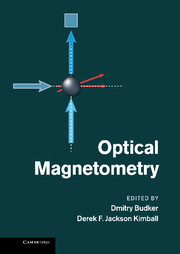Book contents
- Frontmatter
- Contents
- List of contributors
- Preface
- Part I Principles and techniques
- Part II Applications
- 13 Remote detection magnetometry
- 14 Detection of nuclear magnetic resonance with atomic magnetometers
- 15 Space magnetometry
- 16 Detection of biomagnetic fields
- 17 Geophysical applications
- Part III Broader impact
- Index
15 - Space magnetometry
from Part II - Applications
Published online by Cambridge University Press: 05 May 2013
- Frontmatter
- Contents
- List of contributors
- Preface
- Part I Principles and techniques
- Part II Applications
- 13 Remote detection magnetometry
- 14 Detection of nuclear magnetic resonance with atomic magnetometers
- 15 Space magnetometry
- 16 Detection of biomagnetic fields
- 17 Geophysical applications
- Part III Broader impact
- Index
Summary
Introduction
Magnetometry has been an invaluable tool in all stages of space exploration, from the first ionospheric sounding rockets to the most modern interplanetary probes. Our solar system is fundamentally a magnetically active environment – indeed, one might define the extent of the solar system by its heliopause, as it is the magnetic influence of the Sun which separates us from the interstellar medium. The interactions between the solar wind and the bodies of the solar system are varied and complex, and they have strong implications for the past and future of these bodies. Most importantly, a planet's magnetic field is one of the few characteristics which can be measured from space to yield information about the nature and dynamics of its interior. Recognizing these scientific imperatives, mission designers have included precise magnetometers on nearly all the spacecraft used to explore our solar system; this in turn has driven advances in magnetometer technology over the past fifty years.
Achievements of space magnetometry
Discoveries made by space magnetometers have been among the most profound achievements of space exploration. Rocket-borne magnetometers gave the first definitive evidence of electrical currents in the Earth's ionosphere and their effect on diurnal variations of the geomagnetic field [1]. These data not only shed light on the interaction between the solar wind and the Earth; they also complemented radiation studies which mapped out the Van Allen belts and thus paved the way for manned space flight. Later spacecraft magnetometers advanced dynamo theory by confirming the lack of a planet-scale dipolar field on Venus [2,3] and discovering, to much surprise, a still-active dynamo within Mercury [4].
- Type
- Chapter
- Information
- Optical Magnetometry , pp. 285 - 302Publisher: Cambridge University PressPrint publication year: 2013
- 1
- Cited by



